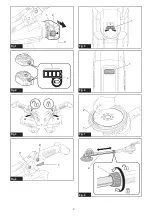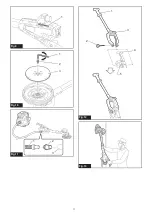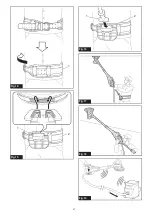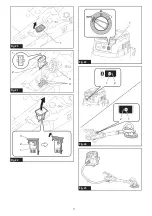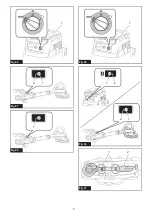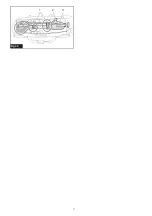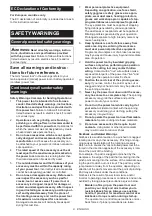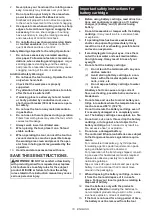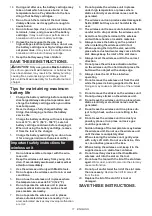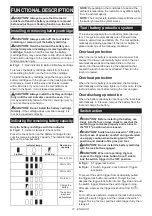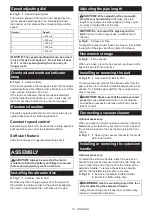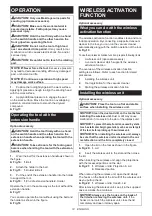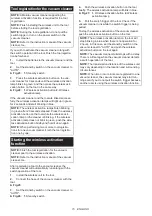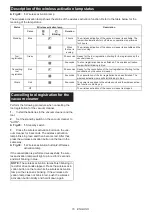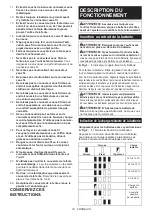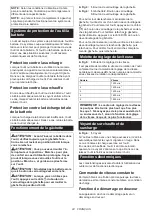
9 ENGLISH
EC Declaration of Conformity
For European countries only
The EC declaration of conformity is included as Annex A
to this instruction manual.
SAFETY WARNINGS
General power tool safety warnings
WARNING:
Read all safety warnings, instruc-
tions, illustrations and specifications provided
with this power tool.
Failure to follow all instructions
listed below may result in electric shock, fire and/or
serious injury.
Save all warnings and instruc-
tions for future reference.
The term "power tool" in the warnings refers to your
mains-operated (corded) power tool or battery-operated
(cordless) power tool.
Cordless drywall sander safety
warnings
Safety Warnings Common for Sanding Operations:
1.
This power tool is intended to function as a
sander. Read all safety warnings, instructions,
illustrations and specifications provided with
this power tool.
Failure to follow all instructions
listed below may result in electric shock, fire and/
or serious injury.
2.
Operations such as grinding, wire brushing,
polishing or cutting-off are not recommended to
be performed with this power tool.
Operations for
which the power tool was not designed may create
a hazard and cause personal injury.
3.
Do not use accessories which are not specifi
-
cally designed and recommended by the tool
manufacturer.
Just because the accessory can
be attached to your power tool, it does not assure
safe operation.
4.
The rated speed of the accessory must be at
least equal to the maximum speed marked on
the power tool.
Accessories running faster than
their rated speed can break and fly apart.
5.
The outside diameter and the thickness of your
accessory must be within the capacity rating
of your power tool.
Incorrectly sized accessories
cannot be adequately guarded or controlled.
6.
Do not use a damaged accessory. Before each
use inspect the accessory such as pad for
cracks, tear or excess wear. If power tool or
accessory is dropped, inspect for damage or
install an undamaged accessory. After inspect-
ing and installing an accessory, position your-
self and bystanders away from the plane of
the rotating accessory and run the power tool
at maximum no-load speed for one minute.
Damaged accessories will normally break apart
during this test time.
7.
Wear personal protective equipment.
Depending on application, use face shield,
safety goggles or safety glasses. As appro-
priate, wear dust mask, hearing protectors,
gloves and workshop apron capable of stop-
ping small abrasive or workpiece fragments.
The eye protection must be capable of stopping
flying debris generated by various operations.
The dust mask or respirator must be capable of
filtrating particles generated by your operation.
Prolonged exposure to high intensity noise may
cause hearing loss.
8.
Keep bystanders a safe distance away from
work area. Anyone entering the work area
must wear personal protective equipment.
Fragments of workpiece or of a broken accessory
may fly away and cause injury beyond immediate
area of operation.
9.
Hold the power tool by insulated gripping
surfaces only, when performing an operation
where the cutting tool may contact hidden
wiring.
Contact with a "live" wire will also make
exposed metal parts of the power tool "live" and
could give the operator an electric shock.
10.
Position the cord clear of the spinning acces-
sory.
If you lose control, the cord may be cut or
snagged and your hand or arm may be pulled into
the spinning accessory.
11.
Never lay the power tool down until the acces-
sory has come to a complete stop.
The spinning
accessory may grab the surface and pull the
power tool out of your control.
12.
Do not run the power tool while carrying it at
your side.
Accidental contact with the spinning
accessory could snag your clothing, pulling the
accessory into your body.
13.
Do not operate the power tool near flammable
materials.
Sparks could ignite these materials.
14.
Do not use accessories that require liquid
coolants.
Using water or other liquid coolants
may result in electrocution or shock.
Kickback and Related Warnings
Kickback is a sudden reaction to a pinched or snagged
rotating pad or any other accessory. Pinching or snag
-
ging causes rapid stalling of the rotating accessory
which in turn causes the uncontrolled power tool to be
forced in the direction opposite of the accessory’s rota
-
tion at the point of the binding.
For example, if a pad is snagged or pinched by the
workpiece, the edge of the pad that is entering into the
pinch point can dig into the surface of the material caus-
ing the pad to climb out or kick out. The pad may either
jump toward or away from the operator, depending on
direction of the pad’s movement at the point of pinching.
Pad may also break under these conditions.
Kickback is the result of power tool misuse and/or
incorrect operating procedures or conditions and can be
avoided by taking proper precautions as given below.
1.
Maintain a firm grip on the power tool and
position your body and arm to allow you to
resist kickback forces. Always use auxiliary
handle, if provided, for maximum control over
kickback or torque reaction during start-up.
The operator can control torque reactions or kick
-
back forces, if proper precautions are taken.
Summary of Contents for DSL801
Page 2: ...1 2 3 Fig 1 1 2 Fig 2 1 A B Fig 3 1 2 3 Fig 4 1 Fig 5 1 Fig 6 1 2 Fig 7 2 1 Fig 8 2 ...
Page 3: ...1 Fig 9 1 2 3 Fig 10 1 2 3 Fig 11 1 2 3 4 5 Fig 12 Fig 13 3 ...
Page 4: ...1 Fig 14 1 2 Fig 15 1 2 Fig 16 Fig 17 Fig 18 Fig 19 4 ...
Page 5: ...1 Fig 20 1 2 3 4 Fig 21 1 2 3 Fig 22 1 Fig 23 1 2 2 1 Fig 24 Fig 25 5 ...
Page 6: ...1 Fig 26 2 1 Fig 27 1 Fig 28 1 Fig 29 1 2 2 1 Fig 30 1 2 Fig 31 6 ...
Page 7: ...1 3 2 Fig 32 7 ...


